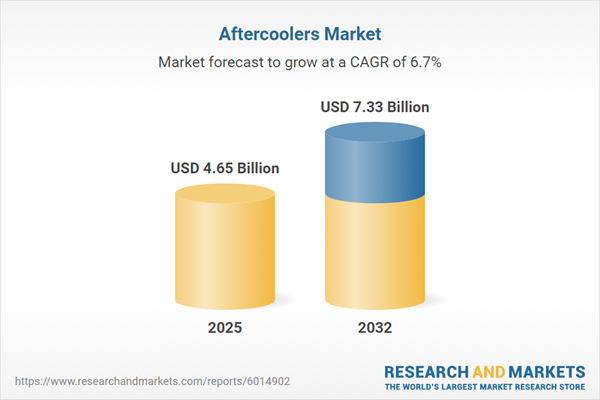Speak directly to the analyst to clarify any post sales queries you may have.
The global aftercoolers market is entering a period of strategic transition, fueled by changing procurement strategies and a rising focus on advanced thermal management. Senior leaders today seek solutions that meet compliance, sustainability, and reliability goals across industrial environments, guiding critical investment and sourcing decisions.
Market Snapshot: Global Aftercoolers Market Overview
The global aftercoolers market is steadily expanding, with a current valuation of USD 4.36 billion in 2024 and a forecasted reach of USD 4.65 billion by 2025. A long-term outlook anticipates growth to USD 7.33 billion by 2032, reflecting a healthy CAGR of 6.72%. This sustained growth highlights the critical need for aftercoolers in supporting reliability and operational compliance. As industries from manufacturing to energy optimize their operations for greater efficiency and risk management, demand for innovative thermal management continues to rise. Leading suppliers are responding by developing solutions that help organizations comply with international standards and strengthen system continuity in a shifting regulatory landscape.
Scope & Segmentation: Insights into the Global Aftercoolers Market
This comprehensive report delivers targeted insights for senior executives, focusing on the commercial, technical, and regional factors shaping aftercooler adoption. Clear segmentation supports informed procurement, investment, and technology strategies in increasingly diverse global industries.
- Cooling Type: Includes air-cooled models with axial or centrifugal fans, glycol-cooled versions utilizing plate and frame or shell and tube designs, and specialized water-cooled systems for unique operational demands.
- Application: Covers automotive manufacturing, oil and gas processing, metallurgy, and power generation, each with distinct regulatory and technical challenges.
- End User: Addresses the needs of healthcare, industrial users, marine operations (onshore and offshore), and petrochemical sectors seeking efficiency and regulatory compliance.
- Capacity: Spans solutions from under 100 kW up to more than 1,500 kW, providing adaptability for diverse project scopes.
- Material: Encompasses aluminum, carbon steel (grades A and B), and stainless steel (304, 316), ensuring performance and durability across global markets.
- Mounting Orientation: Features both horizontal and vertical installation options, enabling effective space utilization and workflow integration.
- Geographical Coverage: Analyzes the Americas, EMEA, and Asia-Pacific, recognizing how industry maturity and local regulation shape technology priorities and supplier opportunities.
- Leading Companies: Examines strategies from Atlas Copco AB, Ingersoll Rand Inc., Parker-Hannifin Corporation, Kaeser Kompressoren SE, Sullair LLC, and Hitachi Industrial Equipment Systems, highlighting their roles in driving global competitiveness.
Key Takeaways: Strategic Insights for Senior Decision-Makers
- Aftercoolers play a central role in enhancing thermal management and supporting system reliability, contributing to improved uptime in compressed air and process installations.
- Real-time monitoring and analytics enable predictive maintenance, reducing unplanned downtime and decreasing long-term service expenses.
- The shift toward using advanced heat transfer technology and sustainable materials ensures readiness for evolving regulatory demands and technical benchmarks.
- Compliance requirements, particularly in North America and Asia-Pacific, influence technology selection and procurement, driving the adoption of regionally aligned solutions.
- Diversified supplier networks and adaptable production capacities allow organizations to manage trade restrictions, optimize supply chains, and ensure regional compliance.
Tariff Impact: Adjusting Supply Chains and Sourcing
Recent US tariff measures have prompted many manufacturers to restructure supply chains, favoring local production and alternative sourcing. This adaptive approach helps organizations address fluctuating operational costs, maintain resilience, and remain efficient in a changing procurement landscape.
Methodology & Data Sources
The findings in this report draw on in-depth interviews with industry leaders, extensive technical literature, and vetted public datasets. Scenario modeling further ensures robust, actionable intelligence tailored to executive priorities.
Why This Report Matters to Industry Leaders
- Enables strategic technology assessments and segmentation analysis to inform investment and scale-up initiatives across dynamic markets.
- Strengthens risk mitigation and supports the digital transformation of supply chains, ensuring responsiveness to regional and industry-specific shifts.
- Empowers senior teams to implement collaborative procurement models for greater operational flexibility and efficiency worldwide.
Conclusion
With continuous advances in technology, sourcing strategies, and material options, the aftercoolers market remains dynamic. This report delivers the intelligence needed for organizations to respond confidently to industry changes and regulatory evolution.
Additional Product Information:
- Purchase of this report includes 1 year online access with quarterly updates.
- This report can be updated on request. Please contact our Customer Experience team using the Ask a Question widget on our website.
Table of Contents
3. Executive Summary
4. Market Overview
7. Cumulative Impact of Artificial Intelligence 2025
Companies Mentioned
The companies profiled in this Aftercoolers market report include:- Atlas Copco AB
- Ingersoll Rand Inc.
- Parker-Hannifin Corporation
- Kaeser Kompressoren SE
- Sullair LLC
- Hitachi Industrial Equipment Systems Co., Ltd.
- BOGE Kompressoren GmbH & Co. KG
- Quincy Compressor LLC
- FS-Elliott Company LLC
- Sullivan-Palatek Inc.
Table Information
| Report Attribute | Details |
|---|---|
| No. of Pages | 194 |
| Published | November 2025 |
| Forecast Period | 2025 - 2032 |
| Estimated Market Value ( USD | $ 4.65 Billion |
| Forecasted Market Value ( USD | $ 7.33 Billion |
| Compound Annual Growth Rate | 6.7% |
| Regions Covered | Global |
| No. of Companies Mentioned | 11 |









